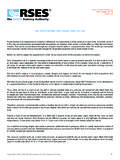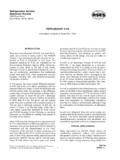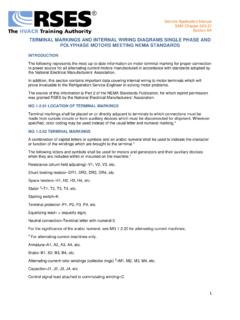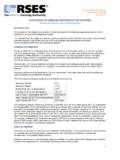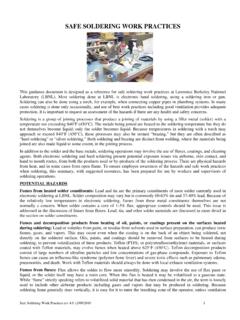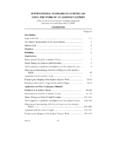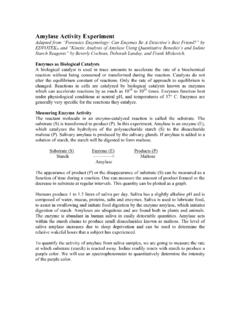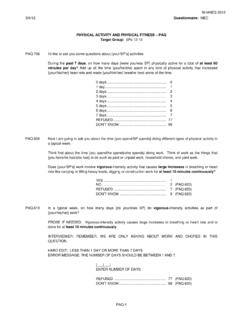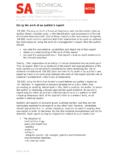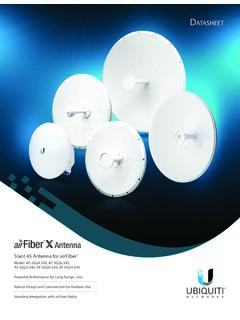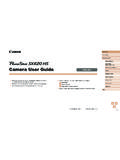Transcription of PRESSURE-ENTHALPY CHARTS AND THEIR USE - RSES
1 Service Application Manual SAM Chapter 620-28 Section 2A PRESSURE-ENTHALPY CHARTS AND THEIR USE By: Dr. Ralph C. Downing du Pont de Nemours & Co., Inc. Freon Products Division INTRODUCTION The refrigerant in a refrigeration system, regardless of type, is present in two different states. It is present as liquid and as vapor (or gas). During the refrigeration cycle, it changes from one state to the other. You need to be familiar with the properties of both liquid and vapor in order to understand the refrigeration cycle. The five properties of vapor are: T, for temperature H, for enthalpy (or heat content) V, for volume S, for entropy P, for pressure These properties are the key to understanding and using refrigerant PRESSURE-ENTHALPY diagrams. Such diagrams chart the properties of gas. Temperature is a measure of how hot or cold an object is. It does not tell how much heat an object will hold, nor does it tell how much heat it takes to change an object's temperature.
2 There are two temperature scales that anyone in refrigeration work should understand. They are the Fahrenheit scale and the Celsius (formerly Centigrade) scale. The Fahrenheit scale is the most commonly used in the United States. The Celsius scale is used in most scientific work in the United States and almost universally in other countries. There is a movement to make the Celsius scale the standard of temperature measurement in the United States. Volume is a measure of the space occupied by refrigerant vapor. In refrigeration work , cubic feet per pound (ft 3/lb) is the standard unit. In refrigeration service work , gauge pressure (psig) is generally used. On a PRESSURE-ENTHALPY diagram, however, the pressure is shown as absolute pressure (psia.) The difference between the two is about pounds per square inch or about 30 inches of mercury ( inches of mercury, to be more precise). This is the difference between atmospheric pressure at sea level and no pressure ( psi less than atmospheric pressure , also referred to as a perfect vacuum ).
3 There are three different kinds of pressure to consider in a study of refrigerants and how temperature affects them. Adding heat to gas when there is no liquid present will cause it to be superheated. The pressure of superheated gas increases very slowly when heated. If the gas is a saturated vapor (that is, if liquid is present), the pressure increases much more rapidly. This pressure is called vapor pressure (or saturated pressure ). Remember that when liquid is present, any pressure value will be vapor pressure . There can be only one value for the pressure at a given temperature for a single refrigerant. (Refrigerant mixtures such as MP39 have a range of 1 Service Application Manual SAM Chapter 620-28 Section 2A PRESSURE-ENTHALPY CHARTS AND THEIR USE By: Dr. Ralph C. Downing du Pont de Nemours & Co., Inc. Freon Products Division pressures for each temperature because of the differences in vapor pressures of the individual refrigerant components.)
4 If heat is added to a container full of liquid refrigerant, it will develop hydrostatic pressure . This pressure increases rapidly in response to a temperature increase. A small increase in temperature in a container full of liquid refrigerant will cause it to develop dangerously high pressure . Never completely fill a cylinder with liquid refrigerant. In dealing with liquid and gas pressures in the refrigeration cycle process, never do anything that might result in hydrostatic pressure . Heat content is also known as enthalpy . It is a measure of how much heat a gas or liquid can hold and how much heat is needed to change the temperature. A gas can have the same heat content at different temperatures only if its other properties, such as pressure and volume, are different. When enthalpy is constant, the condition of the gas is called adiabatic. Entropy is harder to define. It is the ratio of heat content of a gas to its absolute temperature.
5 It remains the same when a gas is compressed, if no heat is added or removed. When entropy is constant, the condition of the gas is called isentropic. SAMPLE DIAGRAMS The most common type of PRESSURE-ENTHALPY diagram is shown in Figures 1A through 1H. They show all five properties for a specific refrigerant in present-day use. pressure is listed along the right and left borders in psia. Horizontal lines are constant pressure lines. enthalpy is listed along the bottom and top of the diagram. Vertical lines are constant enthalpy lines. Temperature, entropy, and volume values are shown in curves. 2 Service Application Manual SAM Chapter 620-28 Section 2A 3 PRESSURE-ENTHALPY CHARTS AND THEIR USE By: Dr. Ralph C. Downing du Pont de Nemours & Co., Inc. Freon Products Division FIGURE 1A. Refrigerant 11. Service Application Manual SAM Chapter 620-28 Section 2A 4 PRESSURE-ENTHALPY CHARTS AND THEIR USE By: Dr.
6 Ralph C. Downing du Pont de Nemours & Co., Inc. Freon Products Division FIGURE 1B. Refrigerant 12. Service Application Manual SAM Chapter 620-28 Section 2A 5 PRESSURE-ENTHALPY CHARTS AND THEIR USE By: Dr. Ralph C. Downing du Pont de Nemours & Co., Inc. Freon Products Division FIGURE 1C. Refrigerant 22. Service Application Manual SAM Chapter 620-28 Section 2A 6 PRESSURE-ENTHALPY CHARTS AND THEIR USE By: Dr. Ralph C. Downing du Pont de Nemours & Co., Inc. Freon Products Division FIGURE 1D. Refrigerant 113. Service Application Manual SAM Chapter 620-28 Section 2A 7 PRESSURE-ENTHALPY CHARTS AND THEIR USE By: Dr. Ralph C. Downing du Pont de Nemours & Co., Inc. Freon Products Division FIGURE 1E. Refrigerant 114. Service Application Manual SAM Chapter 620-28 Section 2A 8 PRESSURE-ENTHALPY CHARTS AND THEIR USE By: Dr. Ralph C. Downing du Pont de Nemours & Co., Inc. Freon Products Division FIGURE 1F.
7 Refrigerant 502. Service Application Manual SAM Chapter 620-28 Section 2A 9 PRESSURE-ENTHALPY CHARTS AND THEIR USE By: Dr. Ralph C. Downing du Pont de Nemours & Co., Inc. Freon Products Division FIGURE 1G. Refrigerant HFC-134a. Service Application Manual SAM Chapter 620-28 Section 2A 10 PRESSURE-ENTHALPY CHARTS AND THEIR USE By: Dr. Ralph C. Downing du Pont de Nemours & Co., Inc. Freon Products Division FIGURE 1H. Refrigerant MP39. Figure 1G applies to HFC-134a, the subject of this text. Figures 2 through 7 use the HFC-134a PRESSURE-ENTHALPY diagram to show the information available from such diagrams when THEIR potential is understood. This means that some lines are omitted in Figures 2 through 7 (the complete diagram is shown in Figure 1G). INTERPRETING THE DIAGRAM The curved line at the left in Figure 2 represents liquid at saturation temperature. Absolute vapor pressure is read on the vertical scale along the left side.
8 enthalpy (heat content) is read on the bottom scale at a number of different temperatures. To the right is a curve representing saturated vapor. This is vapor associated with liquid, and the type of vapor found in a refrigerant cylinder, a condenser, or a flooded evaporator. All of the data to the right of this curve relate to Service Application Manual SAM Chapter 620-28 Section 2A PRESSURE-ENTHALPY CHARTS AND THEIR USE By: Dr. Ralph C. Downing 11 du Pont de Nemours & Co., Inc. Freon Products Division superheated gas, where no liquid can be present. The space between the saturated vapor and the saturated liquid lines represents a mixture of saturated vapor and liquid. FIGURE 2. Liquid and vapor lines. PUTTING THE PRESSURE-ENTHALPY DIAGRAM TO work Compression ratio is a factor that is easily found using the PRESSURE-ENTHALPY diagram, as shown in Figure 3. For example, the evaporating temperature of HFC-134a in a system is 0 F.
9 The condensing temperature is 120 F. Pressures corresponding to these temperatures are read on the left-hand scale. To find the compression ratio, divide the high- pressure value by the low- pressure value. Service Application Manual SAM Chapter 620-28 Section 2A 12 PRESSURE-ENTHALPY CHARTS AND THEIR USE By: Dr. Ralph C. Downing du Pont de Nemours & Co., Inc. Freon Products Division FIGURE 3. Compression ratio. The exact compression ratio of would be difficult to use in basic calculations. So a rounded-off figure of is used in this example. The pressures at this point must be in psia. Correct values can be taken directly from the chart . A compression ratio of means that discharge pressure is slightly less than nine times that of suction pressure . In other words, the compressor must compress the refrigerant gas almost nine times to function efficiently under these conditions. This poses no problem to ordinary reciprocating compressors.
10 They can usually handle compression ratios up to 15. When the ratio exceeds 10, however, a second-stage compressor is recommended. Rotary compressors can deal with compression ratios up to 5, centrifugal compressors up to about 3. The average compression ratio in large-capacity centrifugal units is only about or less in each stage. Service Application Manual SAM Chapter 620-28 Section 2A PRESSURE-ENTHALPY CHARTS AND THEIR USE By: Dr. Ralph C. Downing du Pont de Nemours & Co., Inc. Freon Products Division CHARTING A REFRIGERATION CYCLE Figure 4 is a PRESSURE-ENTHALPY diagram of a typical refrigeration cycle in a system with one pound of HFC-134a. It uses (for this example) evaporating and condensing temperatures of 0 F and 120 F. Points on the diagram are labeled to correspond to locations of equipment in the system. Each step of the cycle can be approached separately. At Point 1, the refrigerant leaves the evaporator and enters the suction valve of the compressor.
